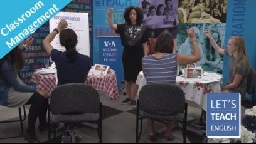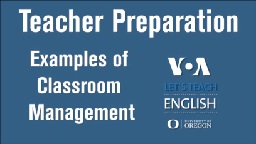|
|
| |
|
|
| |
|
|
|
|
| |
 Let's
Teach English Classroom Management Let's
Teach English Classroom Management
The Let’s Teach English video series offers free online
training for English language educators worldwide. It is
based on the Women Teaching Women English text for
adult, beginning level learners. Voice of America and
the University of Oregon are partners on this project. |
|
|
|
Click to see the full PDF lesson -
opens in a new window. |
|
 Teacher
Resources Examples of Classroom Management Teacher
Resources Examples of Classroom Management
In this final appearance of Let's Teach English, we
present a collection of classroom management tools for
teachers as well as the complete set of teacher and
students texts.
Examples of Classroom Management
In our final video, we explain methods for managing your
communicative language classroom. These methods help you
to group and organize students, get feedback, reduce
teacher talk time and “flip” your classroom.
Thank You to Our Actresses
We are grateful to the hard work and patience of our
actresses in these videos. Some of the 'students' were
international students and Voice of America interns, who
spent two weeks working with us and trying to keep up
with their other duties, too. Our teacher, Alice Bryant,
contributed many wonderful ideas for the series. We also
wish to thank Leslie Opp-Beckman and Linda Wesley, who
edited all of the documents and course materials, helped
to write the scripts, and directed the filming. |
Teacher Preparation Video
Each video transcript for the teacher preparation units is linked below. |
|
 Video Transcript Video Transcript
Narrator: This is a bonus video for this series with examples of managing a
communicative language classroom. These methods are useful for large
classes. They help to create a setting where students can communicate
easily with one another.
Pairing students at random: The teacher asks students to line up so she
can assign random partners. Students talk to find their order in line, and
to
get to know all of their classmates. |
|
|
Teacher: Let's stand up and make a line by your birthdays. January at the
front;
December at the end.
(The teacher gestures to her right and left. Students stand up and form a
line as they ask each other about their birthday months.)
Mimi: I'm January.
Julia: February.
Jamie: May.
Maryam: December.
Teacher: Okay, now bring the line around.
(Students walk to face each other.)
Teacher: The person across from you is your partner.
Teacher: This group – tell about your families.
(Teacher gestures to the other line.)
Teacher: This group – listen and take notes.
(The teacher gestures to one line.)
Teacher: Please have a seat.
Teacher: Please line up by the time you woke up this morning. Who woke up
early?
Stand here.
(The teacher gestures to her left.)
Teacher: Who woke up later? Stand here.
(The teacher gestures to her right. Students line up as they ask each other
what time they woke up.)
Teacher: Okay, now let’s divide here.
(The teacher uses her hand to divide the students into two groups.)
You will be shopkeepers.
(The teacher points to the students to her right.)
Teacher: And you will be shoppers.
(The teacher points to the students to her left.)
Narrator: Cooperative learning: In their cooperative learning groups,
students create
a conversation. In groups of four, students can choose from these roles:
The Writer puts the group’s ideas on paper. The Checker looks up
spellings or meanings of words, asks questions, and watches the time. The
Leader starts the group on the assignment and makes sure everyone
helps and understands. The Speaker introduces the group’s conversation
and contributes to group work.
Teacher: Work with your group to write a conversation about food. Each group
has
a leader, writer, and speaker.
Narrator: Return to teacher focus from group work: When students have been
working in small groups, the teacher may need to call attention back to
herself in order to change to the next activity. In Unit 6, she has them
count down together to begin the next activity.
Teacher: Class, two minutes left. Please finish your work soon.
(The students continue their work.)
Teacher: Okay, class, time’s up!
All: Five, four, three, two, one.
(The teacher holds up her hand and counts backward on her fingers as a
way to call students to attention. The students join her and count
backwards on their hands too.)
Teacher: Are you ready?
Students: Yes!
Teacher: Good!
Narrator: Surveying student pair work: Sometimes, teachers need to know if
student
groups have completed enough work to share with the class. In Unit 8, the
teacher asks students to hold their fingers up against their throats to show
her how many "hopes and dreams" notes they have written about their
partners.
(Students write notes as they discuss their hopes and dreams.)
Teacher: Okay, time’s up! Now, show me the number of notes you have by
placing
that number of fingers on your throat.
(The teacher demonstrates by putting two fingers on her throat. Each
student puts three or four fingers on her throat.)
Teacher: Nice work!
Narrator: Flipping the classroom: In a flipped classroom, students read and
write at
home. Then in class they speak and apply the learning strategies. In Unit
9, students wrote an interview at home.
Teacher: What was your homework? Mimi, please read the project assignment to
help us remember.
Mimi: 1. Choose a job. 2. What do you need to be able to do that job? Make a
list. 3. Write a dialog(ue) with two people – you and an interviewer. 4.
Bring the dialog(ue) to class.
Narrator: Thank you for watching the Let's Teach English series. Like all
VOA
Learning English materials, this series is free for you to use and share. |
|
Transcript Vocabulary
flipped classroom (noun) – A flipped classroom is one where students are
© 2017 University of Oregon and Voice of America. This work is based on the
Women Teaching Women English materials
produced by the University of Oregon American English Institute under U.S.
Department of State Federal Assistance Award
S-LE200-10-GR-050, issued by the U.S. Embassy Beirut. |
|
|
|
|
|
|
|
|
|
|
|
|
Grammar Tips |
Can You Catch These Native Speaker Mistakes?
(Beginner - Listening)
An audio lesson to
help with your understanding of common mistakes. The English is
spoken at 75% of normal speed.
Click here to visit the lesson page with the written script for this
audio program. |
Commonly Confused Words: Part One
(Beginner - Listening,
reading)
A video lesson to
help with your understanding of commonly confused
words.
The English is
spoken at 75% of normal speed.
Click here to visit the lesson page. |
Commonly Confused Words: Part One
(Beginner - Listening)
An audio lesson to
help with your understanding of commonly confused
words. The English is
spoken at 75% of normal speed.
Click here to visit the lesson page with the written script for this
audio program. |
Commonly Confused Words: Part Two
(Beginner - Listening,
reading)
A video lesson to
help with your understanding of commonly confused
words.
The English is
spoken at 75% of normal speed.
Click here to visit the lesson page. |
Commonly Confused Words: Part Two
(Beginner - Listening)
An audio lesson to
help with your understanding of commonly confused
words. The English is
spoken at 75% of normal speed.
Click here to visit the lesson page with the written script for this
audio program. |
|
|
|
|
Search Fun Easy English |
|
|
|
|
|
|
|
|
|
|
|
|
|
|
|
About
Contact
Copyright
Resources
Site Map |